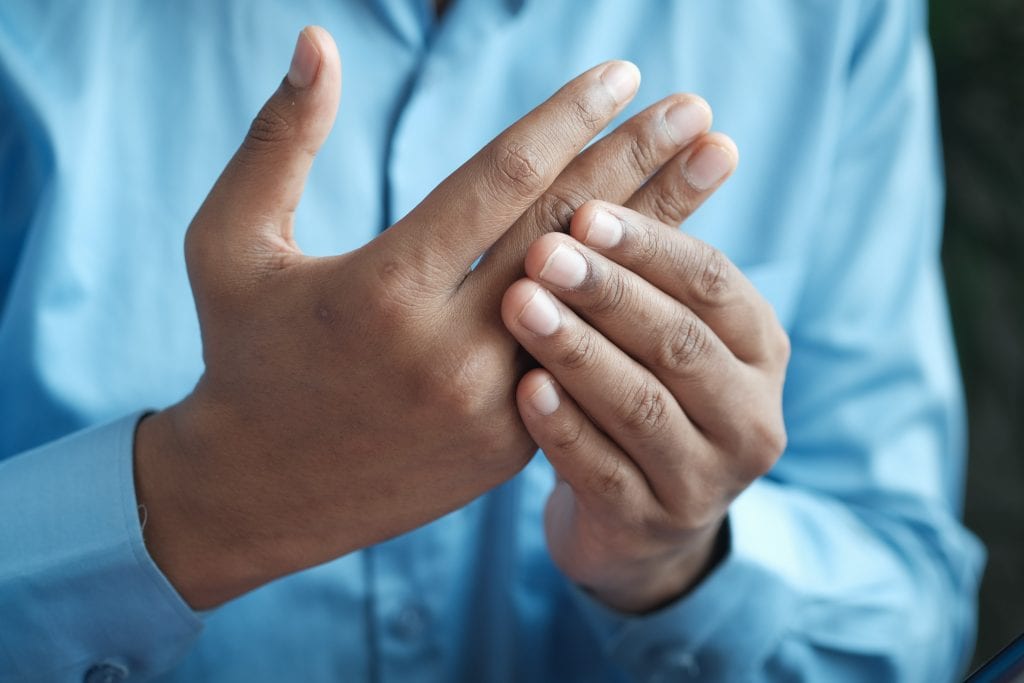Finger pain and finger injuries are very common in Brazilian jiu-jitsu – I certainly had my fair share of them. In this post I will tell you about the most common BJJ finger injuries, what you should do when you have them and how to keep training with them.

How does Brazilian jiu jitsu cause finger joint pain?
If you are a beginner, you probably don’t know the feeling of finger joint pain because of BJJ. But it happens a lot. If there is one thing a beginner should know about this sport it is that it will probably get your fingers hurt.
Some forms of finger pain are benign, whereas others indicate serious injuries and can lead to problems and even arthritis down the way. Whether you can still train BJJ with finger pain, depends on what’s causing the pain.
The fact that finger pain and injuries are so common in BJJ, is the main reason why people tape their fingers in BJJ.
Below I list the most common injuries that cause finger pain and soreness in BJJ, and what you should do when you have them.
Finger sprain – the most common finger injury in BJJ
The most common finger injury in Brazilian jiu-jitsu is a simple finger sprain.
Spains can vary in intensity from mild to very serious.
If your finger is sprained it typically means that you overstretched one of the small joints in your fingers.
Usually this overstretching happens sideways, but it can also happen that you stomp your finger on the mat and it folds over forward or backward.
If you sprain your finger, whether or not you can still train depends on how painful your injury is and how easy it is for you to tape your finger.
Finger sprains can heal up quite quickly, but if you keep training, you’re very likely to keep injuring the ame finger over and over again. This can cause the injury to linger for months.
Swollen finger joint from BJJ
Your finger can swell up from BJJ for any number of reasons.
The first thing you should do is consult with a doctor to see if they think it’s broken. If it’s not broken, you can try the steps below to help you get back on the mats as soon as possible.
Basically, you want to give the RICE treatment: rest, ice, compression and elevation.
Rest: don’t train while the finger is still swollen and hurting.
Ice: Put ice on the swollen finger joint. This numbs the pain and reduces swelling.
Compression: if you can put something around the joint, this will further reduce the swelling. If this is too painful, skip this step.
Elevation: raise the swollen finger to the sky, so that the swelling is pulled down and away from the joint by gravity.
You can also take Ibuprofen or a similar over the counter anti-inflammatory and pain reducing treatment. But don’t take Ibuprofen in order to get back to training – you’ll make the injury worse.
If you train BJJ a lot, you may also get chronically swollen finger joints. This could be due to scar tissue that formed from all the sprains your finger endured over the years.
Jammed finger during BJJ
What I mean by jammed fingers is that you will have a finger stuck in a (usually fully stretched) locked out position and you will need to force it to move.
This usually happens when your fingers are stuck between someone’s gi, belt or someone else’s fingers. You will feel something click in your finger and realize that you can’t move it anymore.
You need to calm down and walk out of the rolling. You should never try to force it out yourself as this could permanently damage your joint.
If you have a jammed finger, you need to go to a medical professional right away. They can diagnose exactly what’s going on and force your finger to move again, in a way that’s as safe as possible.
The only thing you can do at the academy is to take an ibuprofen, possibly put ice on it, and then seek out medical attention.
Dislocated finger in BJJ
If you have a dislocated finger you will see your finger stuck in the wrong position, either sideways or folded over backwards.
This happens when somebody violently breaks your grip and your finger gets stuck in their gi or if you stomp your finger so hard on something that it folds over all the way backwards and is forced out of its socket (I’ve had that with my thumb).
A dislocated finger needs to be put back in the socket of the joint but it’s wise to ask a medical professional to do this as you can damage your tendons if you do it yourself.
You can’t train BJJ with a dislocated finger, but I don’t need to tell you that. You’ll know not to train when your finger is dislocated.
A dislocated finger hurts extremely. I’ve had my thumb dislocated and a finger broken (both outside of BJJ), and I’m not exaggerating if I say that the dislocated finger hurts at least 100 times more than the broken finger.
Also, my thumb has never been the same after the dislocation. It’s always locked out when I wake up and locks out periodically during the day, and it hurts when I bend it. I basically have arthritis in my thumb now. So be careful with your fingers!
Broken finger from BJJ
There are different ways to get a broken finger in BJJ. One of the most common is when you are rolling and someone accidentally steps on your finger. This can happen to anyone, so you should be aware of your surroundings.
A broken finger hurts and it looks ugly. But it’s also a serious injury and you can’t really train without a cast for a while. So be careful.
If you think you broke a finger, go to the doctor. You shouldn’t continue training.
It may feel like you can continue training because broken fingers don’t always hurt so much (especially if you break one of the finger bones inside your hand, rather than your actual finger itself). I actually broke my finger like this once and was doing bench presses the next day, because I hadn’t gone to the doctor yet.
But, the doctor told me that if you train with a broken finger, it can get forced out of position and either heal up in the wrong position, or not heal up at all. So unfortunately you have to take a break from training jiu jitsu (or you can try to train with a cast) if you broke your finger.
Final thoughts on common finger injuries in BJJ
Unfortunately, finger sprains and injuries are a part of the game for many people that train Brazilian jiu-jitsu.
But a lot of finger injuries can be prevented by adjusting your rolling style. just don’t hold onto your grips for dear life; let them go if you feel the tension build.
If you really have a lot of problems with your fingers you should consider whether you want to train nogi or gi BJJ, as no gi is much less hard on the fingers.
And remember that if you suspect you might have a serious finger injury, such as a dislocated finger or a broken finger, you should stop training Jiu Jitsu until you have sought medical advice from a professional.
